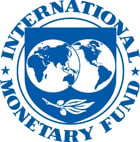
Typical street scene in Santa Ana, El Salvador. (Photo: iStock)
IMF Survey: IMF Revises Up Global Forecast to Near 4% for 2010
January 26, 2010
- World economy bouncing back, but advanced economies drag
- Global recovery from recession led by emerging markets
- Countries should maintain stimulus measures while recovery not well established
The global economy, battered by two years of crisis, is recovering faster than previously anticipated, with world growth bouncing back from negative territory in 2009 to a forecast 3.9 percent this year and 4.3 percent in 2011, the International Monetary Fund said in its latest forecast.

Workers checking wind turbines in the Sichuan Province of China where the economy is forecast to grow by 10 percent overall this year. (photo: Liu Zhongjun/ Xinhua)
Economic Outlook
But the recovery is proceeding at different speeds around the world, with emerging markets, led by Asia relatively vigorous, but advanced economies remaining sluggish and still dependent on government stimulus measures, the IMF said in an update to its World Economic Outlook, published on January 26.
“For the moment, the recovery is very much based on policy decisions and policy actions. The question is when does private demand come and take over. Right now it’s ok, but a year down the line, it will be a big question,” said IMF Chief Economist Olivier Blanchard in an IMF video interview.
IMF Managing Director Dominique Strauss-Kahn has warned that countries risk a return to recession if anti-crisis measures are withdrawn too soon.
The IMF said it had revised upwards its earlier forecast for global growth by ¾ percentage point from the October 2009 forecast.
Risk appetite returning
Along with the update to its forecast, the IMF also released a new assessment of global financial conditions in its Global Financial Stability Report (GFSR). It said that financial markets have rebounded since the lows of last March, the result of improving economic conditions and wide-ranging policy actions by governments.
“Notwithstanding the recent sell-off, risk appetite has returned, equity markets have improved, and capital markets have reopened,” Jose Viñals, Director of the IMF’s Monetary and Capital Markets Department, said.
But policymakers still face extraordinary challenges as they seek to unwind the unprecedented fiscal, monetary, and financial support they provided to keep their economies and financial markets from collapsing, the GFSR update pointed out.
Strength of U.S. consumption
The WEO forecast said that in advanced economies, the beginning of a rebuilding of corporate inventories and the unexpected strength of U.S. consumption had contributed to a rebound in confidence, and inflation was expected to remain contained. But high unemployment rates, rising public debt, and, in some countries, weak household balance sheets present further challenges to the recovery.
The IMF report said that the varying pace of recovery across countries called for a differentiated response in the unwinding of measures used to stimulated the economy and combat the crisis.
Due to the still-fragile nature of the recovery, fiscal policies need to remain supportive of economic activity in the near term, and the fiscal stimulus planned for 2010 should be implemented fully. However, given growing concerns about fiscal sustainability, countries should also make progress in devising and communicating exit strategies.
Financial sector repair
Crucially, there remains a pressing need to continue repairing the financial sector in advanced and hardest-hit emerging economies. In these cases, policies are still needed to tackle bank’s impaired assets and restructuring. Unwinding the financial sector support measures gradual; it can be facilitated by incentives that make measures less attractive as conditions improve.
Policymakers will also need to move boldly to reform the financial sector with the objectives of reducing the risks of future instability and rethinking how the potential fallout of financial crises would be borne in the future, while at the same time making the sector more effective and resilient.
At the same time, some emerging market countries will have to design policies to manage a surge of capital inflows. Macro-prudential policies can be used to address the potential for bubbles at an early stage by limiting a buildup in risks.



